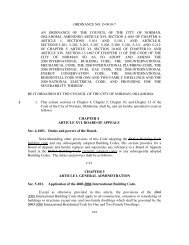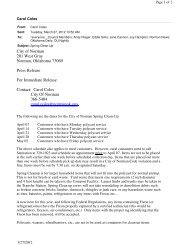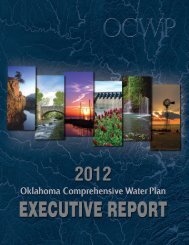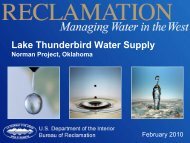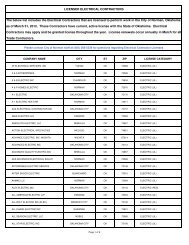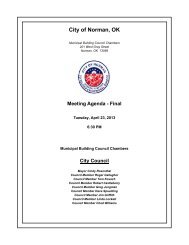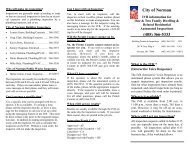2011 Water Conservation Plan - City of Norman
2011 Water Conservation Plan - City of Norman
2011 Water Conservation Plan - City of Norman
You also want an ePaper? Increase the reach of your titles
YUMPU automatically turns print PDFs into web optimized ePapers that Google loves.
<strong>City</strong> <strong>of</strong> <strong>Norman</strong><strong>Water</strong> <strong>Conservation</strong> <strong>Plan</strong> <strong>2011</strong>2.2 <strong>Water</strong> Treatment <strong>Plan</strong>t Raw water is delivered by the COMCD to <strong>Norman</strong>’s water treatmentplant. <strong>Plan</strong>t design is conventional s<strong>of</strong>tening and it was constructed in the mid 1960’s. The plantwas upgraded in 1982 and is currently undergoing improvements. Figure 2 is the futuretreatment process for <strong>Norman</strong>’s water treatment plant.Figure 2.2.3 OKC Emergency Connection The supply line connecting <strong>Norman</strong> to Oklahoma <strong>City</strong> providesan emergency supply source. Maximum delivery rate can vary from 6.5 to 9 MGD depending onseason and ultimately the pressure differential between Oklahoma <strong>City</strong> and <strong>Norman</strong>. This sourceis a last resort supply since its cost is greater than what <strong>Norman</strong>’s rate structure will support on acontinual basis. The vault connection is located at the northwest boundary <strong>of</strong> <strong>City</strong> limits.3.0 WATER RIGHTS vs PRODUCTION3.1 <strong>Water</strong> Supply Permitted Rights- Wells A majority <strong>of</strong> <strong>Norman</strong>’s ground water right permitsare temporary permits which allow withdrawal <strong>of</strong> 2 acre-ft <strong>of</strong> water per acre per year. <strong>Norman</strong> ispermitted for approximately 28,600 acre-ft <strong>of</strong> ground water which equates to roughly 9.3 billiongallons per year. The Garber-Wellington aquifer is currently being studied by the Oklahoma<strong>Water</strong> Resources Board and the Association <strong>of</strong> Central Oklahoma Governments (ACOG).Preliminary data suggests that the sustainable yield is much less than the current water rightsissued under temporary permits. ACOG indicates the recharge rate is approximately 2 inches peryear which suggests that the sustainable yield will probably be between 0.25 and 0.5 acre-ft <strong>of</strong>water per year. If the decision is made to reduce the yield to 0.5 acre-ft <strong>of</strong> water per year, theNUA’s water rights will be 2.33 billion gallons per year or an average <strong>of</strong> 6.4 Million Gallons perDay (MGD). This reduced yield would only allow for 36 wells operating 70% <strong>of</strong> the timethroughout the year. Therefore, if the temporary permits are reduced before becoming finalpermits, additional ground water rights will be necessary.3




